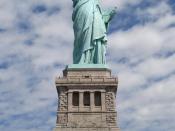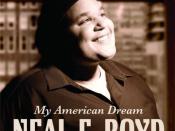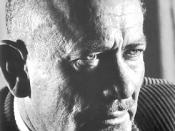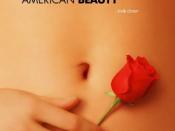The dreams, which a society creates, have an important role in the lives of the people in that society. In particular, the 'American Dream', for the characters of both John Steinbeck's prose fiction Of Mice and Men and Sam Mendes' film American Beauty, is presented as a powerful concept through its appealing nature, which offers happiness and a better life. However, for the characters to live this dream they must make sacrifices.
Within the two texts, the 'American Dream', governed by the society's context, values, and ideals, presents the society's depiction of happiness. Steinbeck's Of Mice and Men was written in the 1930's, set in California, America -focusing on the many lives of itinerant, manual, male-workers who were affected by the Great Depression. The lack of security and stability in this life resulted in great loneliness and hardship for the men, as they were solely dependent on the whims of employers and the availability of work.
In these times of adversity, the workers created dreams for themselves to sustain their unpleasant life and give them hope for the future. The dream for the majority of the workers revealed a longing for a better life, stereotypical of the American Dream; one of independence, equality, wealth, the prospect of owning their own land, untarnished happiness and the freedom to follow their desires such as to "say the hell with goin' to work".
In contrast, the society of Mendes' film, American Beauty, reflects the middle class white suburban America during the 19990's. Their dream conveys the notion that happiness is achieved with superficial values; including perfection, materialistic possession, a successful image, beauty, a 'white picket fence' suburban home, and the perfect family. The artificial beauty aspect of this dream is signified by the films title American Beauty; a direct reference to a specific breed of roses, which is outwardly perfect through its cultivation for flawlessness. Conversely, like most house-grown roses, it has no scent, and therefore the definition of beauty and perfection becomes replaced with falseness.
To accomplish these dreams the characters, in their respective society, sacrifices different aspects of their life, this in turn affects themselves and the people around them. In American Beauty, the character of Angela represents the television-sitcom stereotype of an American teenager; a typical blonde-haired, beautiful, male-attention-seeking, popular girl. Angela puts on a superficial sexual exterior to mask her tremendous insecurity and fear of being "ordinary", by trying to exist as an adult in an adult world despite the reality of her youth. In doing so, she has sacrificed her integrity to obtain reputation and the image of perfection, created by the 'American Dream'. How Angela approaches the value of beauty is highlighted through the mirror motif, which symbolises her vain nature. This concept of a false beauty is echoed in representation of the 'American Beauty' rose as an exterior restriction to Angela's beauty.
Similarly, the character of Curley's wife in Of Mice and Men benefits from her physical appearance to gain attention; however, she does not do this to exemplify the society's image of perfection or beauty (like Angela) but to obtain company. Despite her characters representation as a "tramp" and the temptation of female sexuality in a male-dominated world, Curley's wife is not entirely a villainous or unsympathetic character. She sacrifices her own dreams of a glamorous life in Hollywood as an actress to have the stability in life, which a marriage to a wealthy man offers. However, she makes a poor choice of husband and is left feeling lonely, unhappy with her marriage and with a broken dream.
The unhappiness, which derives from the failure of the dream, is also apparent for those living the dream. From the very beginning, Lester, the protagonist of American Beauty, is shown to be living the 'American Dream'; he is wealthy, owns a beautiful suburban house, maintains a highflying job, and is married with a daughter. Lester had to sacrifice his youthful ideals (his identity, respect, love and a meaningful relationship with his family) to achieve the suburban 'American Dream', which he discovers to be false. Instead of being happy and fulfilled in life, Lester is unable to communicate with either wife or daughter, which both see him as "this gigantic loser", who is apathetic, "sedated", a figure to be laughed at and despised. Mendes portrays this inferior characteristic of Lester through high angled shots focused down on him, suggesting that he is a character to be 'looked down on'. The misery in living an unwanted dream is visually symbolised by his constant entrapment behind various objects -such as the shower cubicle, the window of his own home, and the rigid and confining structure of his work place.
The combination of his realisation of the falsity of the dream and his sudden infatuation with his daughter's friend, Angela, contributes to his liberation by throwing off his hypocritical facades -including his dehumanising corporate job, and any pretence that he cares about anything but his own appetites. This triggers his reversion to adolescence as he tries to recapture the remembered joy of his youth. This new life, in which Lester relives his adolescent dream, is juxtaposed to his previous depressing life in the two opposing dinner scenes. The first dinner scene captures Lester as submissive character whereas in the second scene it appears that Lester has become more arrogant and superior. Although the concept of being more powerful is an alluring one, Lester realises again that this too is a false dream as he begins to live a carefree, responsibility-lacking life of a young man.
The negativity results from living the 'American Dream' are also seen in Steinbeck's characterisation of Curley in Of Mice and Men. Curley's achievement of wealth, power, land (all the different aspects which articulates the 'American Dream' in this text) is overshadowed by his violent nature, abuse of power, selfishness and lack of respect from all the other characters. Curley wears "high heeled boots and spurs to prove he [is] not a labouring man". This reveals that he takes advantage of materialistic possession (which are represented by the boots) and violence (represented by the spurs) to distinguish himself as boss and of higher status. Liked by no one, not even his wife, Curley demonstrates how the dream affects a character negatively.
In the two societies of American Beauty and Of Mice and Men, it becomes clear to both the characters and the audience that the 'American Dream' is a disillusionment, as it does not provide either happiness or a better life. For the middle class Americans, Mendes focuses on the falsity and superficiality of the 'American Dream'. The film highlights how people want to give the illusion that they are living the dream -but behind closed doors, the reality is that the characters are far from true happiness; the breakdown of family life is witnessed, there is a ready availability of illicit drugs, violence is exposed, and characters are sacrificing personal passion until living has been forgotten.
Steinbeck, on the other hand, emphasises the futility of the 'American Dream' for the ranch workers, such as Lennie and George. For these characters, there is no certainty or surety in either their life or dream. Steinbeck conveys this by foreshadowing how so many elements (including Lennies retardation, Curley's character, etc) conspires to destroy their dream. The sacrifices made to achieve this dream is said to be a tragic one.
BIBLIOGRAPHY:Of Mice and MEN -a novel by John SteinbeckAmerican Beauty - a film directed by Mendes





